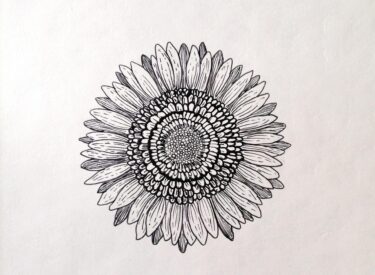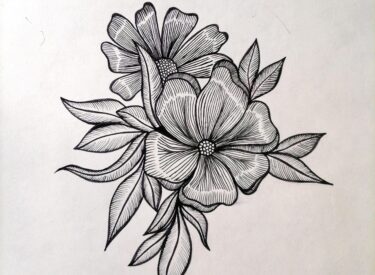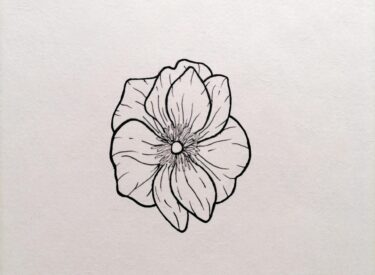Flowers Pencil Drawings? Do you desire to become an expert in the art of rendering easy floral sketches using pencils?
If the intricacies of flower sketches elude you, then be relieved, for this piece will provide you with a comprehensive guide on drawing flowers with ease.
Follow the ensuing steps meticulously to create exquisite floral sketches that will leave art enthusiasts in awe. In addition, a free online tutorial is also available to assist you in honing your skills.
Here are some easy tips for drawing flowers with pencils:
The daisy is an excellent choice for beginners who want to learn the art of floral sketching. Its striking and vivid petals bear a close semblance to roses and other flowers.
To sketch a daisy, begin by creating a small slanted cup, and then trace out the petals and leaves.
For a lotus, trace the central part of the flower and then include the petals and stem.
Afterward, enhance your sketch by applying shading with a pencil.
Another effortless flower drawing technique is to trace the petals. These flowers usually feature a large stem and take the form of an inverted fork.
Draw the stem and leaves separately, and then sketch the central part of the flower in the shape of a heart.
Finally, draw a long, curved line from the center of the flower. Similarly, a daisy flower drawing requires eight oval-shaped petals and a wavy stem. To add depth to your sketch, utilize a shading pencil.
If you wish to endeavor the task of depicting a cosmos flower, it will prove to be quite an intricate undertaking.
In order to accurately portray this flower, it is imperative to first draw two concentric circles with a gap measuring one centimeter between them.
The outermost circle should be the length of the flower petals, whereas the innermost circle ought to consist of several semi-circular patterns. Subsequently, it is important to color the petals, stem and leaves with identical hues.
For those individuals who possess a proclivity towards flowers, it may be desirable to acquire the ability to depict them artistically.
In this composition, we will present some rudimentary guidelines for drawing flowers. Furthermore, we shall elucidate the process of sketching varying species of flowers.
The initial phase encompasses the arrangement of petals. For instance, the stem of the flower may be positioned centrally within the flower. Following this, it is imperative to draft the stem and leaves.
The following step entails depicting the rose petals. To represent rose petals, it is necessary to draw three concentric circles. Subsequently, spiral lines ought to be inscribed to embellish the flower’s appearance.
Thereafter, one must draft the petals. In actuality, the petals represent the most challenging aspect of the rose’s depiction.
However, with practice, it can be achieved with ease. The outcome may even surprise you!
Pencil sketches of flowers offer a seemingly uncomplicated way to sharpen one’s sketching proficiency.
The process of creating a rose, for instance, requires drawing three concentric circles and spiraling lines amid each one. An open heart-like figure is then delineated, and each petal is shaded with dots at varying points, culminating in the smudging of the petals for a more authentic appearance.
Alternatively, one may opt to trace the petals for another flower sketch, with the blooms appearing akin to a flipped fork atop a lengthy stem, alongside leaves that are sketched independently. In the center, one is to draw a heart-shaped outline, and a twisted line is to be depicted springing from the middle of the bloom.
Additionally, for a daisy flower sketch, one needs to draw eight rounded petals and a crimpy stem. Shading pencils can add depth and dimension to these sketches.
Not only are pencil flower sketches easy to execute, but they also afford one the freedom to unleash their creative prowess by devising unique and innovative designs.
A basic idea of how to sketch a flower can be attained via a step-by-step tutorial, after which one may introduce intricate details and textures to their artwork.
After creating a fundamental outline, you can incorporate intricate elements, including leaves, stems, and petals, to endow your creation with more complexity and vitality.
Incorporating shapes can instill more dimensionality and dynamism into your designs. Additionally, the undulating lines along the periphery of your design can accentuate its depth.
Infusing small imperfections can further enhance the realism of your floral rendering, imbuing it with greater liveliness. Don’t forget to include the center of the flower for an added touch of detail.
Flower petals exhibit a wide array of tonalities. To draw a rose, for instance, you must utilize a combination of light and dark shades.
To achieve this, you must utilize shading pencils to incorporate shadows and highlights into your design. It is advisable to use an actual photograph of the flower as a reference before delving into your own imaginative creation.
Once you have a reference point, you can begin crafting your own distinct design. So, take pleasure in your newfound hobby!
Now, you are prepared to embark on your inaugural floral sketch. It is uncomplicated to draft a sunflower or tulip.
Simply sketch two circles and arrange them side-by-side. Then, utilize the smaller circle as a template to outline the stems and leaves.
With just one sketch, you can manipulate the form of the flower as you see fit. The original illustration is refined and captivating.
If you lack experience in sketching flowers, there are several measures to executing a beautiful and verisimilar floral depiction. Irrespective of your level of proficiency, there exists a flower scheme suited to your artistic inclination.
Dedicate some time to mastering the process and cultivating your personal style. Before long, you will produce exquisite flower artwork that you can proudly showcase.
If you have previously attempted flower illustrations, you will rapidly craft a striking masterpiece. You will discover that there is nothing beyond your artistic reach.
As with any drawing, the foremost step is organizing your equipment. If you intend to employ a pencil and paper, prepare the paper beforehand to optimize the drawing outcome.
The right tools will facilitate the drawing process. A comprehensible guide can also teach you invaluable techniques. In no time at all, you will accomplish a beautiful and artistically refined floral illustration.
Another crucial measure in drawing flowers is creating your individual reference point. A circle or square can serve as a reference guide to outline a central point.
Following a meticulous guide, you can generate stunning nature-inspired artwork. This method serves as an excellent introduction to executing floral depictions.
After determining a set of guidelines and selecting a color scheme for the floral sketch, the process of drawing the flower can commence.
This creative pursuit can be enjoyed by both novices and professionals, as these directives enable individuals to acquire the ability to depict flowers of all varieties.
Following the drawing stage, the flower can be shaded with colored pencils. If desired, a lighter colored pencil can also be used to apply color to the final product.
Once the foundation of the flower has been established, the following step can be initiated.
When starting the process of sketching a flower, one must take care to ensure that each flower retains a similar basic structure. This decision aids in facilitating modifications to the sketch in the future.
A solid foundation provides the framework for the successful creation of a beautiful floral sketch. In addition to sketching, one may also seek to learn how to paint flowers, as it presents an opportunity to enhance one’s drawing technique.
If the goal is to create stunning floral pencil sketches,certain practices should be adhered to.
Firstly, drawing smoothly is imperative and should be attempted in natural light as it reduces the likelihood of overly elongated lines.
Secondly, when utilizing a pen, careful attention must be paid to the overlapping and foreshortening of elements. It is worth noting that ink will dry within minutes of being applied, so a wet rag should be kept on hand to erase unwanted ink markings.
The appearance of flowers during the summer months is a beautiful sight, and capturing their essence in a sketch can result in an extraordinary end product.
Floral pencil drawings present an excellent opportunity to unleash your creativity and develop your skills. The process is easy, to begin with, and the results can inspire you to create a variety of other floral designs.
By browsing examples of flowers on the web and practicing simple petal patterns and strokes, even beginners can produce beautiful drawings of orchids or roses.
Once you’ve mastered the basics, you can move on to more intricate works, using various artists’ examples as inspiration.
Floral pencil drawings can help you explore different design possibilities, even if you’re new to the craft. By experimenting with different flowers and drawing techniques, you can create unique and distinctive artwork.
To improve your skills, it’s a good idea to study examples of floral art and borrow some of their techniques. Remember that the key to success is not to be afraid to start small and build from there.
While floral pencil drawings are relatively simple to create, it’s important to remember that mastering the art form takes time and practice.
While nature cannot be replicated, you can learn valuable drawing principles by studying the works of famous artists. Whether you choose to follow contemporary artists or those who specialize in nature paintings, studying their portfolios can provide inspiration and guide your stylistic choices.
Ultimately, the art of floral pencil drawing is a rewarding and enjoyable activity that can help you develop your creativity and drawing skills.
By starting with simple techniques and gradually building your skills,you can create unique and beautiful artwork that can inspire you and others for years to come.
The intricate art of drawing flowers can be a daunting task for beginners. However, with a basic understanding of proportions and shading techniques, anyone can create stunning floral artwork.
While there are countless varieties of flowers to choose from, the rose and the lotus are two popular choices for beginners.
The rose, with its heart-shaped petals, is often considered the easiest flower to draw.To begin, one can simply draw the petals in the shape of a heart and then proceed to draw the stem and leaves using similar techniques.
However, to make the flower appear more realistic, an artist must understand the proportions of the different parts of the flower, particularly the overlapping petals.
Another popular flower to draw is the lotus. While this flower can be challenging to replicate, a simple tracing technique can be used to capture the central part of the flower and its side petals.
The petals can then be shaded using a variety of colors to create a stunning visual effect.
To create depth and add realism to a floral drawing, an artist can use hatching techniques to create different types of lines. Thick hatching lines can be used for light areas, while thin lines can be used for darker areas.
A daisy, with its simple yet beautiful appearance, is an excellent choice for practicing this technique.
Conclusion for Easy Flowers Pencil Drawing
We hope that you will definitely learn from scratch how to draw easy flower pencil drawings.
Check out:
All gold gradient background images
All sunset gradient background images
All spotify gradient background images
All instagram gradient images background
All blue shades backgrounds images
All pink shades background images











